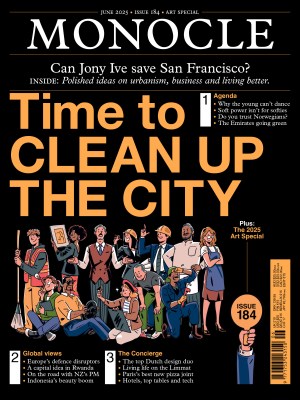Interview: Sou Fujimoto on restoring balance with nature
Ahead of a career retrospective, the Japanese architect and Expo 2025 masterplanner remains committed to breaking boundaries.
“These are sketchbooks from the very beginning of my architecture-school days,” says Sou Fujimoto. “Each is numbered: year, date, book number.” The Japanese architect picks up a yellow one and starts looking through it. It’s dated 13 January 1993 – his third year as a student. “Of course, I still have a sketchbook but lately I’ve been doing digital sketches on an iPad because I can share them more easily with my team.”
He could be forgiven for sacrificing the beauty of a hand-drawn sketch for convenience. After all, he’s been busy: he master-planned the Expo 2025 site in Osaka, which opened to the world in April, and is now preparing for his first major retrospective, to be held at Tokyo’s Mori Art Museum from July to November.
Ahead of this showcase, which covers more than three decades, Monocle meets Fujimoto at his studio in Tokyo’s Koto City. He has de-archived every sketchbook and model from his career, laying them out on the studio floor. “We’re not just showing old models,” he says. “We are making new ones too. People will see that the thinking and the process are ongoing.”

It’s a process that started at the University of Tokyo. “I wanted to study physics but I couldn’t understand anything,” says Fujimoto, laughing. “I finally chose architecture. The only architect I knew at that time was Antoni Gaudí. Then my classes introduced me to Le Corbusier and Mies van der Rohe.” On learning about these modernist masters, Fujimoto became hooked. “They not only created new shapes and spaces but also lifestyles. That was fascinating to me.” While the architect’s output looks very different to that of his early idols, there are parallels. Like Le Corbusier, Fujimoto believes that architecture should be in harmony with the natural world.
“Early in my career I realised that I was creating boundaries between inside and out,” he says. “But I thought that they should disappear. And I am not just talking about physical architecture; I also mean social and philosophical boundaries. As an architect, the question for me is: how do we create beautiful relationships between human life and society, and the surrounding nature?”
Some clues might lie in Fujimoto’s projects, such as House N (2008) – a home in Oita, Japan, that features layers of walls and windows that provide both privacy from neighbours and views to nature – or his 2013 Serpentine Pavilion in London, in which a semi transparent grid of white steel tubes offered views across the site in Hyde Park. Many of his other projects reference organic structures, such as birds’ nests, caves and forests.
Despite the accolades that he has received for his approach, Fujimoto doesn’t think that his work is particularly groundbreaking. “In the past, our lives were closer to nature but we created boundaries to resist it in the hope of a more comfortable life within an artificial environment,” he says. “But over the past 150 years, we have found that it’s strange to be isolated from the wonder of nature.” So how can architects redress the balance? “By digging deeper and understanding locality in terms of nature and materials,” he says. “In doing so, we will find something unique, allowing the merging of boundaries and connecting people’s lives with the surrounding nature – and people with each other.”
The CV
1971: Born in Hokkaido, Japan.
1994: Graduates from the University of Tokyo with a degree in architecture.
2000: Establishes Sou Fujimoto Architects in Tokyo.
2006: Wins gold in the house competition by the Tokyo Society of Architects & Building Engineers.
2008: Wins the Japanese Institute of Architecture grand prize.
2010: Completes Musashino Art University Museum & Library in Tokyo.
2013: Creates the Serpentine Gallery Pavilion in London.
2018: Builds L’Arbre Blanc, a village-like housing development inspired by trees in Montpellier, France.
2020: Completes Forest of Music in Budapest, a museum in the Hungarian capital’s most famous park.
2025: Master-plans Expo 2025 in Osaka, Japan.


